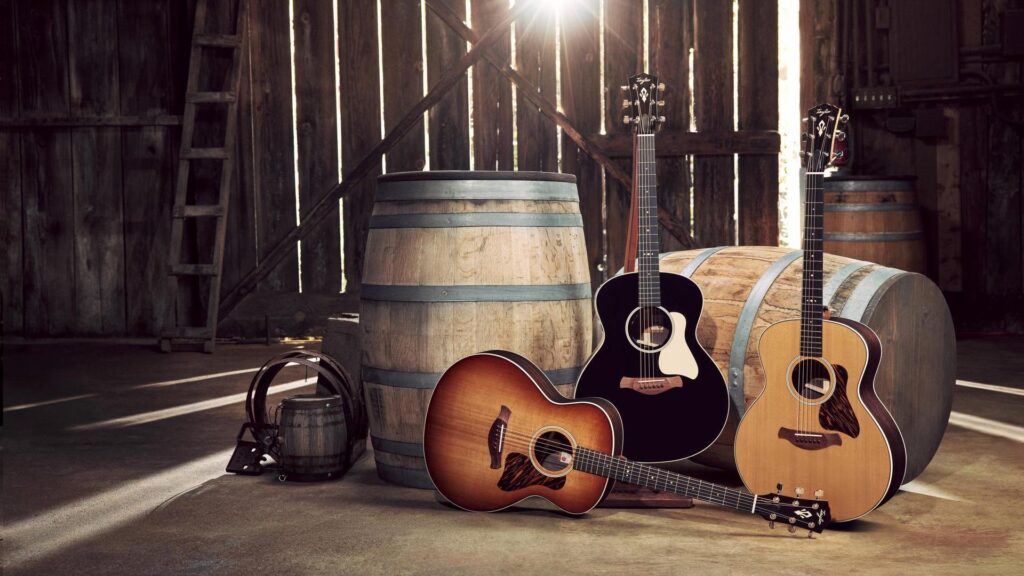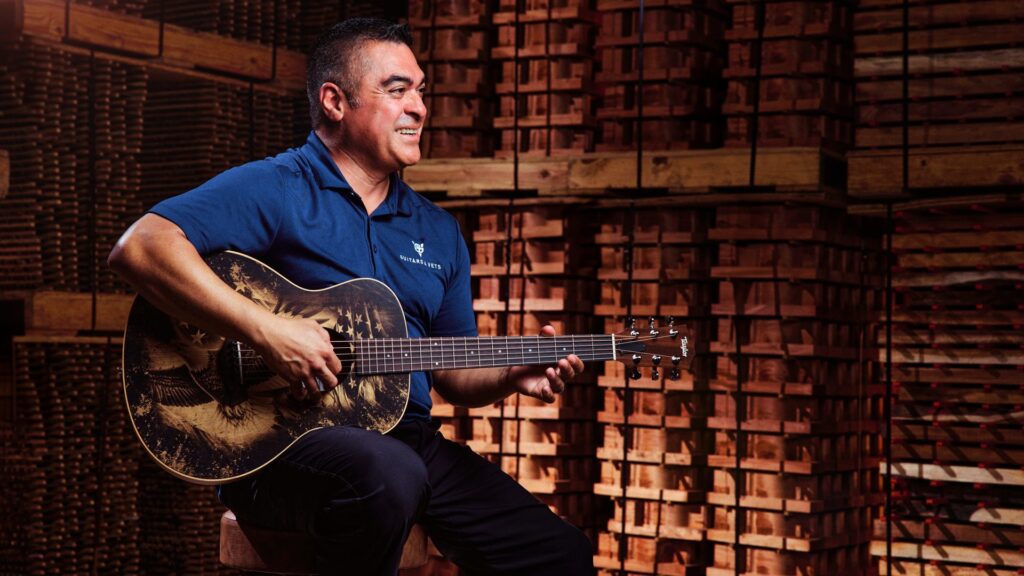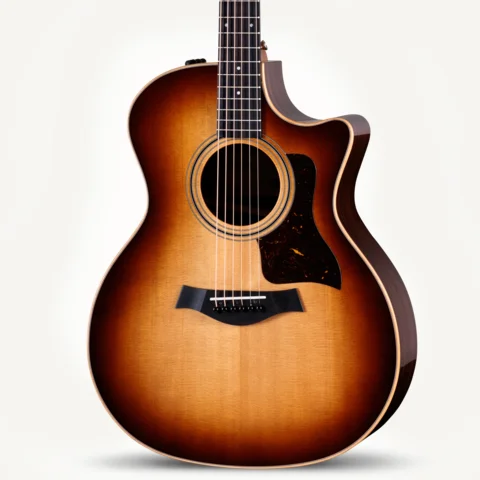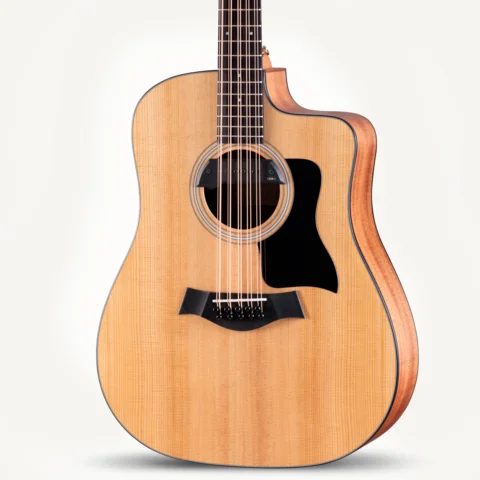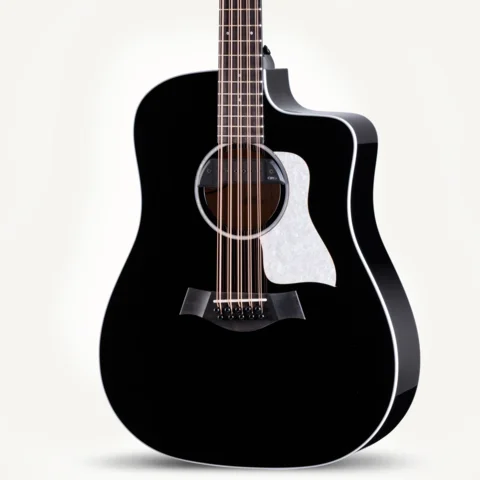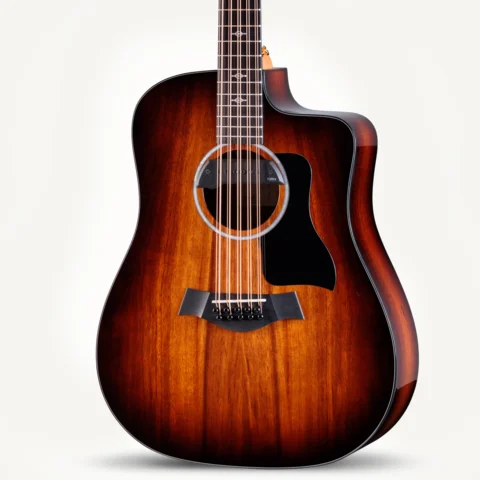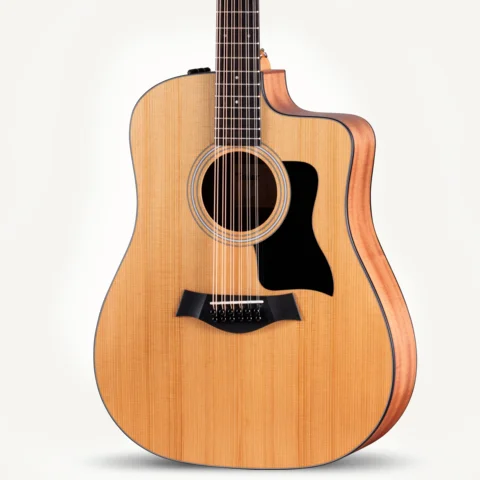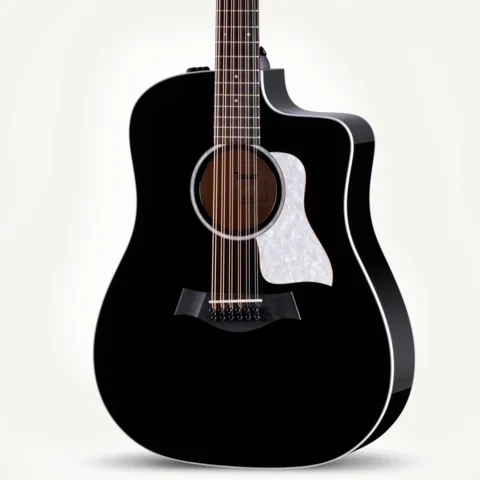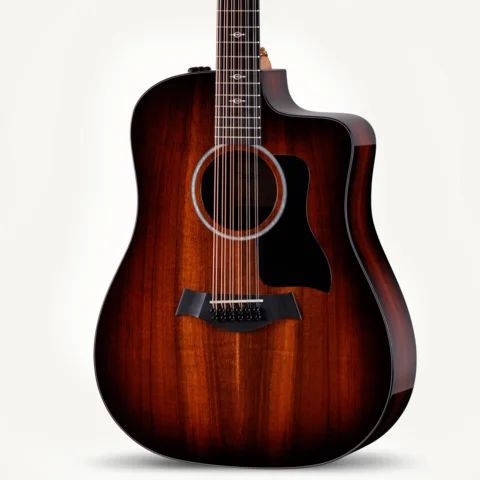I’m excited to share one of my favorite guitar-playing techniques: a Latin rhythm fingerstyle pattern with percussive effects. I first learned the “coolness” of independent right hand thumb and finger playing from lessons with Mick Goodrick, a jazz guitarist and instructor at Berklee College of Music, back in Boston many years ago. Since then, it seems I’ve always had gigs that featured solo guitar and vocal at some point in the evening — including shows with Manhattan Transfer, Rickie Lee Jones, Bette Midler and Natalie Cole — so I’ve put this to good use. Over the years I’ve developed many different patterns, but they all have a common thread: to simulate all the essential parts of a band’s rhythm section — bass, drums/percussion, and harmony (guitar) — played simultaneously.
This is a fingerstyle concept, so if you use a pick, you can lose it for now. Thumb picks are acceptable, but I prefer the sound and feel of the thumb’s flesh. Although this style of comping seems to be made for nylon-string guitar, you can also apply it to steel-string and even electric guitar, with each instrument producing a unique sonic flavor. I use this concept in a variety of situations with all of my gigs, on different guitars, and for different musical textures, not just Latin grooves. With some practice, you’ll be able to do the same.
One last note before we begin. There are several details to incorporate into this lesson (although it is only two measures long). Because these details are very visual, it may be helpful to watch my companion video to this lesson now. In fact, you may be able to “get” most of the lesson just from the video.
OK, time to assume your playing position! For your fretting hand, we’re going to use a basic Am7 bar chord on the fifth fret. For your picking hand, you’ll want your thumb on top of the sixth string and fingers 1-4 below strings 4-1, in that exact order. You should be touching every string except the fifth. Your thumb will eventually play it as it alternates between strings 6 and 5.
This playing pattern can take a lot of repetition before you feel comfortable. If your fretting hand cramps up along the way, feel free to change chords or even let go of the neck entirely for a break, but be sure to keep your picking hand pattern going. Since this is more of a physical exercise and you’re actually trying to promote muscle memory, you may find it less fatiguing (once you start to “get” it) to watch TV while you practice. When I first moved to Los Angeles and started working on my right hand thumb and finger independence, I would practice these and other fingerstyle string sequence patterns while watching a movie every afternoon, not thinking too much but working on the patterns to develop that muscle memory. It was amazing what I was able to accomplish in a week. Of course, when you start to apply your newly learned pattern(s) and make music, you’ll want to turn the TV off and your creative brain back on! This process will be like learning to ride a bike: unnatural at first, but once you get it, you’ll never forget it.
Let’s look at Figures 1a-c. Here you see all three elements (guitar chords, percussive finger clicks, and bass notes) in a two-measure pattern that repeats over and over via notation and tablature. We are going to divide each measure into eighth notes, so we’ll have eight beats per measure: four downbeats and four upbeats. Notice that the pattern starts on the “&” of beat 4 going into it. A metronome will be helpful as you count these eighth notes in your head or out loud:
& [: 1 & 2 & 3 & 4 & | 1 & 2 & 3 & 4 & :]
Everything in this lesson is either on a downbeat (1, 2, 3 or 4) or on the “&” beat, an upbeat. Visualizing both is helpful for proper rhythmic placement while playing.
The Bass Pattern
Let’s start with just your thumb playing the bass line (Fig. 1c). Keeping your fingers in place below strings 4-1, start with your thumb on top of the sixth string, using mainly the side of your thumb’s flesh. All bass notes are down strokes. Remember, we’re holding down that Am7 bar chord on the fifth fret with your other hand. Count off one measure: 1 & 2 & 3 & 4 &. You start the pattern on the “&” of 4 and come right back to play the downbeat (1), holding it through beat 2. On the “&” of 2 you play the E on the fifth string, seventh fret, and then come right back and play it again on the downbeat (3), holding it through beat 4. At this point, it simply starts over again. The second measure is identical to the first.
Note the rhythmic symmetry for your bass line. You play four times per measure on beats 1, “&” of 2, 3 and “&” of 4. The first two notes are A, the second two notes are E. The notes on beats 1 and 3 are sustained, and the beats on the “&”s are shorter. I’m sure you’ve heard this common Latin pattern before. Practice it over and over with a metronome until it’s ingrained in your soul. It will be the backbone for not only this pattern, but many derivations. Next, it starts to get interesting!
The Chord Pattern
Now we’re going to add our chords on top of this bass line. Fig. 1a is what this looks like. Notice that this pattern also starts on the “&” of beat 4. What is unique about this chord pattern is that it continues being played on every “&” of all four beats (every upbeat). This constant upbeat makes this pattern totally symmetrical. It does not change. That said, I’d like to note a little detail regarding your fretting hand that’s holding down the Am7. As you start the pattern (on the “&” of 4), the first chord is “tied” over the bar line to the downbeat (1), which is why that downbeat is not played. You should hold down (sustain) the chord through this beat (1) until you re-pluck it on the “&” of 1. This re-pluck is not sustained as it is followed by a rest. This is when you can let up on the chord, or “take a breath,” as we say when talking about phrasing. The following “&”s are played the same way (in groups of two): first long, then short, long, short, long, short, etc. And that’s the whole chord pattern.
Combining Patterns
Now let’s try putting our two separate patterns (Fig. 1a and 1c) together. This is the part that’s like climbing on a bike for the first time. Hang in there. You’ll get it and it will be fun! We’ll get to the third element, the percussive click, in a moment. In playing them together we’re going to slow the process down and look at the activity for each individual eighth note. Your beginning “&” of 4 starts with both parts. Pluck your thumb (bass) and fingers (chord) simultaneously, Am7. On the downbeat (1), re-pluck just your thumb (bass) on the sixth string (A) while your fingered chord remains held down from the initial pluck. On the “&” of 1, while holding down your bass note, pluck another upbeat with your fingers (chord). Now let’s insert the percussive click (Fig 1b). On the downbeat (2), continue to sustain the bass note, but take your fingers that just plucked the chord and tap them back into playing position between the strings to create a percussive sound. Often, a finger or two will make it all the way to the guitar’s top as you tap, which is where the “click” term comes from. I’ll cover these percussive clicks more in the companion video.
So far we’ve covered four eighth notes, with three individual patterns (bass, chord and percussive click) played simultaneously. Rhythmically, you’re done! These four eighth notes simply repeat to complete the measure, with one alteration: the bass note (thumb) changes in this second half of the measure to the E, fifth string, seventh fret (remember the opening exercise, Fig. 1c?). Let’s walk through this last half measure with the bass note change. We left off on the downbeat 2 performing the click.
Now this eighth-note pattern starts all over again on the “&” of 2 with the bass (thumb) and fingers (chord) playing together, but this time our bass note is the E on the fifth string, seventh fret. On the downbeat (3), you re-pluck just your thumb (bass) on the fifth string E while your fingered chord remains held down from the previous eighth note. On the “&” of 3, while holding down your bass note, pluck another upbeat with your fingers (chord) and finally, on the downbeat (4), you perform another click.
Since we started our measure with an eighth note pickup on the “&” of beat 4, we are now back to the beginning of the pattern, ready to start it all over again for the identical second measure. Down the line when you feel comfortable with this two-measure Am7 pattern, try substituting another chord in the second measure, such as D9. (The Am7 to D9 pattern is very popular.) From here, you can start playing different chord progressions and entire songs. You’ll probably be coming up with your own derivations of this pattern as well. The only thing to be aware of when playing different chords is the string order of bass notes. Depending on whether the root of each chord is on the sixth string or fifth string, your first degree to fifth degree bass line will either be sixth string (root/first degree) to fifth string (fifth degree), as in this lesson, or fifth string (root/first degree) to sixth string (fifth degree). When playing a chord whose root is on the fifth string, the fifth of that chord is always on the same fret (as the root), sixth string.
One final note on percussive clicks: If you grow your fingernails out for picking, and especially if you use a coating to strengthen them, be aware that aggressive “clicks,” where you actually tap the guitar top, can leave very small dents in the finish. Over time it can become more visible. You can protect the guitar top in that area with a variety of non-adhesive, cling-on, removable pickguards. If you need more information, contact Taylor’s Customer Service department.
That wraps up this lesson. As I mentioned earlier, because of the specific details presented here, my companion video will provide a useful visual reference. Watching it will help you smoothly integrate these pattern elements. I’ll also include extra tips, including an extended chord progression using this lesson’s technique, along with several variations. Good luck and make it fun!
You can find Wayne at www.WayneJohnsonOnline.com



























